The best comprehensive birding of Vietnam
- Category
- Long birding tours
- Destinations
- Cat Tien - Da Lat - Di Linh - Yokdon - Mang Den - Ngoc Linh - Bach Ma - Phong Nha - Cuc Phuong - Tam Dao
- Duration
- 22 days
- Hotel
- Standard to 4-stars
- Price
- 4,600 USD
Introduction
Vietnam is one of the most beautiful, friendly and fascinating countries in Asia. An early season visit there finds the country at its best, the climate mostly cool, dry and enjoyable, the winter birds still present and the resident ones gearing up for breeding season. Due to recent taxonomic "splits", Vietnam hosts no less than 14 true endemic species, and this number continues to increase as further work is done, and new discoveries made. A further 30 or so Vietnamese bird species are restricted to Indochina and there are a number of very interesting and distinct “subspecies”, several of which are destined to be future "splits" into new species. A large range of Southeast Asian species of wider distribution and a host of birds wintering from further north add to the richness of Viet Nam's avian diversity.
List of the most wanted species
Vietnam is also host to the largest selection of mammals of any Southeast Asian country. Many are critically endangered, little-known and almost impossible to see, but among them are more than 20 species of primate – an astonishing total for such a relatively small country. Some are widespread, but a unique aspect of this tour is to seek out some of the rarer ones – especially a number of colourful Leaf-Monkeys and two species of endemic Gibbons. We have a chance of seeing up to six species (Delacour’s and Ha Tinh Leaf-Monkeys, Black-shanked and Red-shanked Douc Langurs and Buff-cheeked and Northern White-cheeked Gibbons) some of which are among the rarest primates on earth, hanging on in their last isolated strongholds.
Our unique and comprehensive itinerary, covering the best sites from south to north, seeks out all but a few inaccessible endemic birds and several of the mammals. The tour was run successfully from 2011 to 2018, and in 2016 we reconsidered all birding conditions in Vietnam, and discovered some new birding spots and eliminated visits to other famous spots which are now less productive. For example: Lo Xo Pass is replaced by Mang Ri and we reduced the time spent at Bach Ma, where the weather is usually damp, wet and misty; we also added Sa Mu pass as a reliable site for seeing the Rufous-cheeked Laughingthrush. Moreover, Fansipan Mountain in Sa Pa is easy to reach by a new cable-car which started to operate in April 2016; this gives us a chance to explore Viet Nam's two mysterious endemic birds, White-throated Wren-babbler and Pale-throated Wren-babbler. Thus, we shall see Viet Nam's unique range of bird and other species in a way that few westerners have ever enjoyed. Of course, opportunities for bird and other wildlife photography on this tour are outstanding, with easy to moderate birding conditions.
Our knowledgeable guides and professional service will help you to see most of Viet Nam's endemic birds and more than 300 other species during the trip. Transport is by minibus, accommodations are in luxury/good standard hotels and park bungalows and we will enjoy memorable Vietnamese food throughout. The price includes park entry fees, local transportation and all meals.
Customize tour is availble for private group, please contact us your your inquiry
Detail Itinerary
Day 1 (D) - Arrival day
Arrival in Ho Chi Minh City (Saigon), pick up at the airport and transfer to Victory hotel
Optional
If time permits, we can visit Go Cong beach, a river mouth in Mekong delta, this mudflat is home for some interest targets such as “White-faced” Plover, Nordman Greenshank, other common shorebirds and, especially, Spoon-billed Sandpiper. More about this option
Welcome dinner and briefing
Overnight in Ho Chi Minh City
Day 2 (B, L, D) - Transfer to Cat Tien National Park
After an early start we will drive northwards towards the renowned Cat Tien National Park for our first exploration of the Park in the afternoon.
Overnight at the Cat Tien National Park headquarters guesthouse (3 nights)
Day 3 & 4 (B, L, D) - Birding in Cat Tien NP
The premier National Park in South Vietnam, Cat Tien is located in Cochinchina in the Da Lat foothills and boasts an impressive mosaic of forest and seasonal wetlands which largely escaped the defoliants used in the Vietnam War. We will bird using jeep tracks and forest trails to seek out the endemic Germain’s Peackock-Pheasant, other spectacular birds such as Siamese Fireback, Green Peafowl and Scaly-breasted Partridge, endemic Pittas, the endemic Grey-faced Tit-Babbler and a host of other species also known from Malaysia and Thailand.
Key species
Orange-necked Partridge, Germain's Peacock Pheasant, Siamese Fireback, Green Peafowl, Wreathed Hornbill, Blue-rumped and Bar-bellied Pittas, Pale-headed and Black-and-buff Woodpeckers, Black-and-red, Banded, Dusky Broadbills, Blyth’s Frogmouth, Grey-faced Tit Babbler.
Day 5 (B, L, D) - Transfer to Di Linh
We leave Cat Tien for the relatively short drive to Di Linh. Certain birds can be easier to locate here at the Nui San Pass than in Da Lat, including Blue and Rusty-naped Pittas, Spotted Forktail, White-cheeked, Black-hooded and Orange-breasted Laughing-Thrushes, Vietnamese Cutia and “Black-headed” Parrotbill, a probable split from the more widespread Grey-headed Parrotbill.
Overnight Sillverfall Villa
Day 6 (B, L, D) - Birding Di Linh - Transfer to Da Lat
After an early morning return to the Nui San pass (which will give us our first chance for the elusive Green Cochoa), we will drive up to the Langbian Plateau and the evocative French hill-town resort of Da Lat. We will stop to bird any interesting patches of habitat en route and we'll also see several attractive waterfalls. Da Lat is situated at a delightfully cool 1475 m (4800 feet) asl in a temperate region dotted with lakes and waterfalls and surrounded by forest, including various native pine woodlands.
Overnight Da Lat city (3 nights)
Day 7 & 8 (B, L, D) - Birding in Da Lat
We will explore the Da Lat Plateau including the 2169 m (7100 feet) asl Mt Langbian, cloaked with evergreen forest right up to its peak and accessed by a progressively-steeper footpath. Our efforts should be rewarded, however, as this is the home of the spectacular endemic Collared Laughing-Thrush, as well as Yellow-billed Nuthatch and the Vietnamese forms of Cutia, Rufous-winged (Black-crowned) Fulvetta and Black-throated (Grey-crowned) Tit which are sure-fire bets for splitting before too long. The elusive and handsome Green Cochoa is also here and should be vocal at this time of year; a number of other Asian and wintering birds will also be encountered.
Nearer to Da Lat itself is Ta Nung Valley, famous for the relatively recently re-discovered Grey-crowned Crocias which is regularly encountered here. Other endemics such as Black-hooded and Orange-breasted Laughingthrushes and Vietnamese Greenfinch are also possible.
Key species
Bar-backed Partridge, Silver Pheasant, Red-vented Barbet, Black-browed Barbet (split as Annam Barbet), Red-headed Trogon, Long-tailed Broadbill, Wedge-tailed Green Pigeon, Mountain Imperial Pigeon, Rufous-bellied Eagle, Jerdon’s Baza, Rusty-naped Pitta, Blue Pitta, Burmese Shrike, Indochinese Green Magpie, Eurasian Jay, Slender-billed Oriole, Maroon Oriole, White-throated Rock Thrush, Green Cochoa, Rufous-browed Flycatcher, Blue-and-White Flycatcher, Mugimaki Flycatcher, Snowy-browed Flycatcher, Little Pied Flycatcher, Large Niltava, Lesser Shortwing, White-tailed Robin, Spotted Forktail, Yellow-billed Nuthatch, Yellow-cheeked Tit, Grey-crowned Tit, Grey-bellied Tesia, White-spectacled Warbler, Chestnut-crowned Warbler, Black-hooded Laughingthrush, White-cheeked Laughingthrush, Orange-breasted Laughingthrush, Collared Laughingthrush, White-browed Scimitar Babbler, Streaked Wren Babbler, Eyebrowed Wren Babbler, Pygmy Wren Babbler, Rufous-capped Babbler, Vietnamese Cutia, Chestnut-fronted Shrike-Babbler, Da Lat Shrike-Babbler (split from White-browed), Blue-winged Minla, Black-crowned Fulvetta, Indochinese Fulvetta (no chance on this itinerary), Grey-crowned Crocias, Rufous-backed Sibia, Black-headed Sibia, Black-headed Parrotbill, Mrs Gould’s Sunbird, Streaked Spiderhunter, Vietnamese Greenfinch, Red Crossbill, Brown Bullfinch.
Day 9 (B, L, D) - Transfer to Ban Me Thuot
We make an early morning departure for Ban Me Thuot and a stop at Lak Lake for some waterbirds and wintering warblers en route. Later on we reach Yok Don National Park for a 1-night stay at Ban Don Tourism Area. Our main target here is Mekong Wagtail, but other species such as Black-headed Woodpecker, Collared Falconet, White-rumped Falcon, Chestnut-bellied Nuthatch are among the specialties.
Overnight Yok Don National Park (1 night)
Day 10 (B, L, D) - Birding in Yok Don NP - Transfer to Mang Den
After our morning birding Yok Don the heading to Mang Den with a relative long driving
Overnight T&T hotel (2 nights)
Day 11 (B, L, D) - Birding in Mang Den
Our main target for a full day of birding at Mang Canh is the Chestnut-eared Laughingthrush, but we will also be on the lookout for Black-hooded Laughingthrush, Pale-capped Pigeon, the endemic Ratchet-tailed Treepie and we have another chance for Yellow-billed Nuthatch, as well as our first chance tosee the Brown Hornbill.
Key species
Pale-capped Pigeon, Northern Brown Hornbill, Stripe-breasted Woodpecker, White-winged Magpie, Ratchet-tailed Treepie, Pale Blue Flycatcher, Grey-crowned Tit, Rufous-faced Warbler, Grey-headed Parrotbill, Indochinese Wren-babbler, Chestnut-eared Laughingthrush, Black-hooded Laughingthrush, Grey-crowned Crocias (rare), Rufous-backed Sibia, Grey-faced Warbler, Blue-rumped, Blue and Rusty-naped Pittas.
Day 12 (B, L, D) - Transfer to Dak To or Tu Mo Rong
In the morning, we will bird in the Mang Den area to pick up a few more to complete our bird list. In the late afternoon we will drive on to Dak To town for 1-night stay. If time permits, we can take further drive to the very small town of Tu Mo Rong, where a small guesthouse can accommodate maximum 6 people.
Overnight at Hoang Gia Trang hotel (2 night)
Day 13 (B, L, D) - Birding at Mang Ri - Special quest for Golden-winged Laughingthrush
Mang Ri pass, a new road crossing the Ngoc Linh Natural Reserve, was completed in May, 2016. This is now THE site to see the endemic Golden-winged Laughingthush, as well as the Indochinese Fulvetta, and Black-crowned Barwing. Here, at the forest edge, we have a great chance of finding this recently-described species and others, and to look for the Brown Hornbill, Indochinese Wren-Babbler (formerly known as Short-tailed Scimitar-Babbler), White-winged Magpie, Red-tailed Laughingthrush, Himalayan Cutia, Green Shrike-babbler and a another chance for Yellow-billed Nuthatch.
Overnight at Hoang Gia Trang hotel
Day 14 (B, L, D) - Birding in Bach Ma - Transfer to Khe Sanh
We will spend a morning birding again at Ngoc Linh if we miss something on previoous day, otherwise we drive all the way (with some enroute birding and relaxing) to Khe Sanh city in Quang Tri province, near Laos border
Overnight at Green Hotel (Khe Sanh town)
Day 15 (B, L, D) - Birding at Sa Mu pass
We leave early this morning for a 2.5-hour drive to Shamu Pass via the Ho Chi Minh trail's western branch. This is a fairly new spot near the Laos border that is home to the near-endemics Rufous-cheeked Laughingthrush, Indochinese Wren Babbler and the rarely-seen Moustached Barbet.
This afternoon we drive to Phong Nha and Ke Bang National Park
Overnight at Sai Gon-Phong Nha hotel (2 nights)
Day 16 (B, L, D) - Birding in Phong Nha Ke Bang National Park
Two major birding target species will occupy our time in Phong Nha: The near-endemic Sooty Babbler and Limestone Leaf-warbler (also found in similar habitats in adjacent Laos) . Here we also have further chances for a range of birds including Siamese Fireback, Red-collared Woodpecker, Brown Hornbill as well as the isolated form of Sulphur-breasted Warbler now split as “Limestone Warbler”
Day 17 (B, L, D) - Driving northward
We will conduct a predawn search for two endangered primates - Black and Ha Tinh Leaf Monkeys as well as the beautiful Red-shanked Duoc langur before the drive north to Cuc Phuong National Park, but we might break up this long drive.
Those ending the tour on today will be transferred to Dong Hoi airport.
Night at Cuc Phuong national park (night 0 of extension)
Northern extension
Day 18 (B, L, D) - Drive to Cuc Phuong, stop for en route birding at Van Long
We leave early for Cuc Phuong and stop en route at Van Long Van Long Nature Reserve, 30km from Cuc Phong, where we will take a sampan ride to some dramatic limestone cliffs that are one of the last haunts of the critically endangered Delacour’s Leaf-Monkey.
Cuc Phong is Vietnam’s oldest National Park and an area of lowland forest and lakes easily accessed by a paved road. It is rich in birdlife and here we have our last chances to see both Pitta species, Red-collared Woodpecker and White-winged Magpie as well as a supporting cast which includes Malayan Night-Heron, Pied Falconet, Eared Pitta, Silver-breasted Broadbill, White-tailed Flycatcher, Fujian Niltava and the annamensis form of Limestone Wren-Babbler.
Overnight at Cuc Phuong National Park (2 nights)
Day 19 (B, L, D) - Birding in Cuc Phuong National Park
We will have our final morning's birding at the Bong area, then we drive back to the Park’s gate for afternoon birding around the nearby botanical garden, as well as visiting the Primate Center.
Cuc Phuong National Park
Day 20 (B, L, D) - Transfer to Tam Dao
Our last morning in Cuc Phuong will be spent looking for the White-winged Magpie, and also Rachet-tailed Treepie if we have missed them before.
In the afternoon, we will drive to Tam Dao Mountain for 2 nights.
Overnight at Gia Le hotel (2 nights)
Day 21 (B, L, D) - Birding in Tam Dao National Park
Our targets in Tam Dao are the Blue-naped Pitta, Short-tailed Parrotbill and Grey Laughingthrus, Streak-breasted Scimitar Babbler but also many other sought-after species. This will be the best opportunity to finalise our trip with species such as the Ashy Bulbul, Black-throated Laughingthrus, Chestnut Bulbul, Fujian Niltava, White-gorgeted Flycatcher, Coral-billed Scimitar Babbler, Spot-necked Babbler, Chestnut-collared Yuhina (split from Striated), Greater Rufous-headed and Short-tailed Parrotbills, and Collared Treepie.
Day 22 (B, L) - Birding in Tam Dao, tour ends
We have a full morning of birding at Tam Dao summit, and later we spend a bit time in the mid-altitudes of the mountain.
After lunch, we will take a short drive to Noi Bai airport to meet your evening flights home.
---------------
A northern further extension can be also be added for Ba Be (White-eared Night-heron) and Sa Pa; 1 week of birding at these two sites is recommended.
Other Tours
Tour Categories
Most popular tours
Scheduled tours
Tour Pictures
.jpg)
Black-crowned Barwing, one the most interesting birds

Golden-winged Laughingthrush, very few birds have seen this newly discovery which will be one of our main targets

Red-shanked Douc Langur, not only birds but mammals are also in our targets
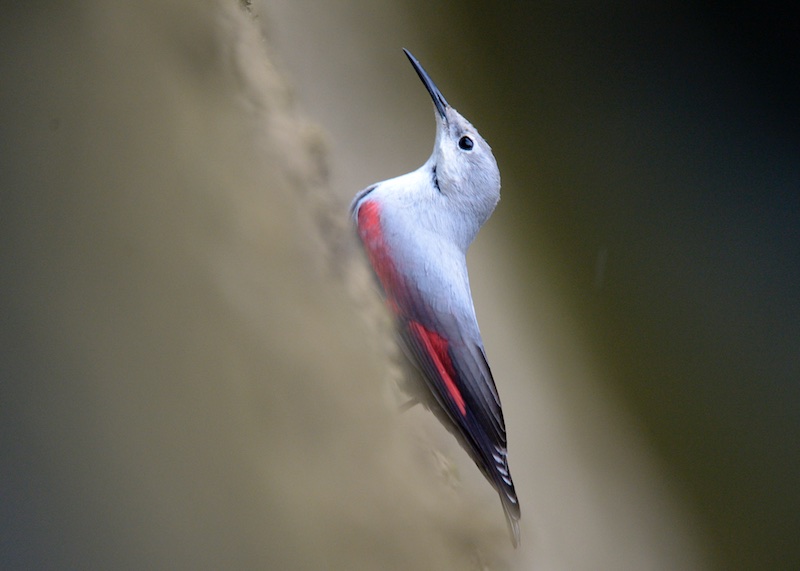
Wallcreeper, new record to Vietnam on our tour in November, 2017

Orange-breasted Laughingthrush, very elusive shy bird
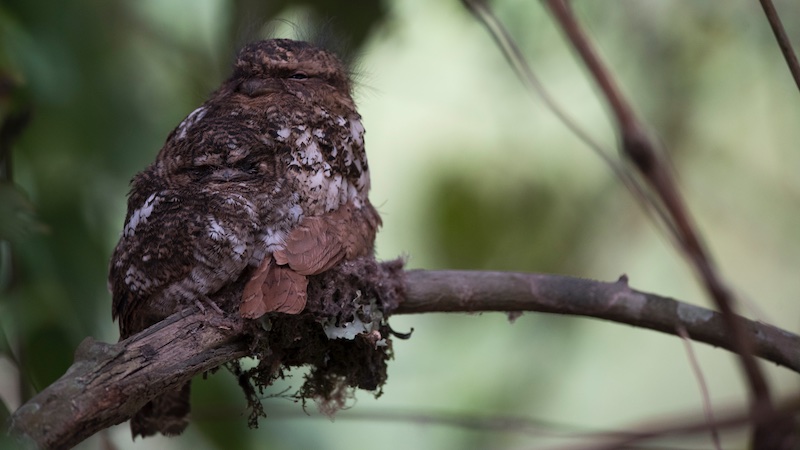
Hodgson's Frogmouth is one of our nocturnal targets

Blue-rumped Pitta
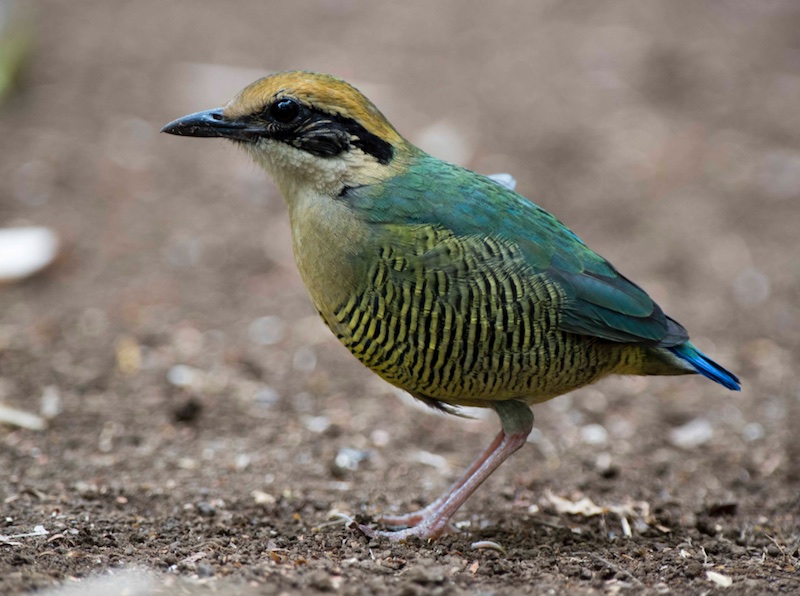
Bar-bellied Pitta, one of the most wanted bird while birding in Cat Tien
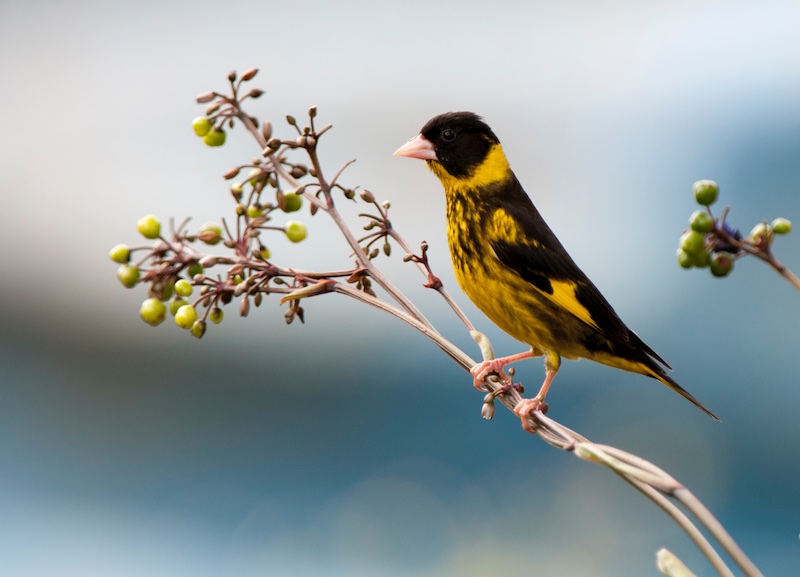
Vietnamese Greenfinch, endemic but easy in Da Lat
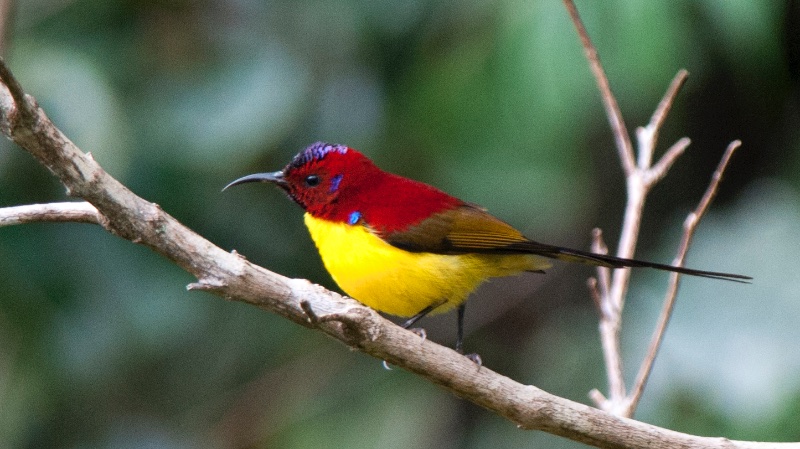
Local subspecies of Gould Sunbird (Aethopyga gouldiae annamensis), common in Da Lat

Blue-naped Pitta, a hard bird of Tam Dao

Black-and-red Broadbill, a beautiful species which is easy to see in Cat Tien
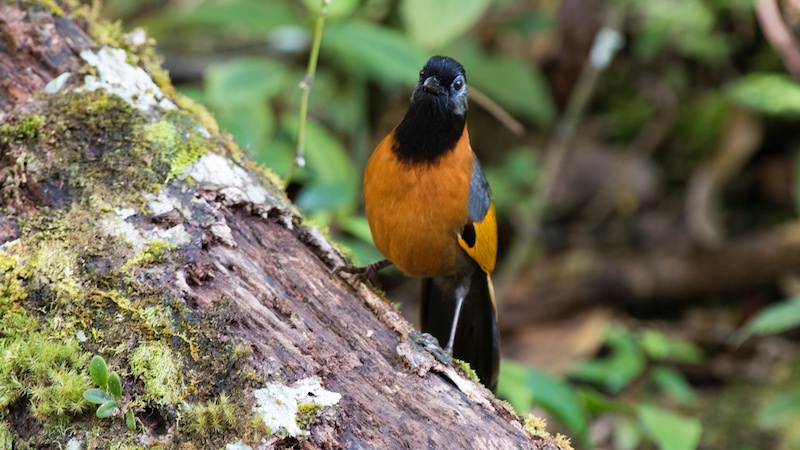
Collared Laughingthrush, an endemic to Da Lat